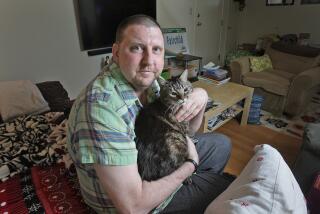EUTHANASIA : Despite Foes, ‘Right-to-Die’ Group Grows
- Share via
EUGENE, Ore. — Derek Humphry remembers the time a few years ago when a caller to a radio talk show said he wished Humphry, the founder of the National Hemlock Society, was seated in an electric chair so he, the caller, could throw the switch.
Humphry, a genial Briton and former journalist, says those kinds of calls are balanced by letters from people who thank him. “My loved one died well” is a typical comment, he noted.
Humphry’s organization advocates a “right to die” for terminally ill patients. “Death with dignity,” supporters call it.
Humphry, 60, is executive director of the society and edits a quarterly newsletter that goes out to 36,000 members in 67 chapters around the country from its headquarters here.
Publicity seems to come his way every two or three years.
“There is a flurry of attention now,” Humphry said, because of two deaths this summer. Janet Adkins, a National Hemlock member, ended her life in June with the help of a suicide machine built by a Detroit doctor, Jack Kevorkian. Adkins, diagnosed as having Alzheimer’s disease, made the decision with her family to take her life while she still had her mental faculties.
Then, in mid-August, a Sacramento, Calif., couple flew to Michigan, believing that aiding suicide was legal in that state. Robert Harper, 72, assisted his wife of 23 years, Ginger, suffering from painful breast and liver cancer, in committing suicide. Harper was arrested for murder and faces trial on Jan. 21.
Harper is the first member of the National Hemlock Society to be charged with murder, and the society is paying for his defense.
Humphry, facing heavy opposition from the Catholic Church and other religious groups, responds that “a lot of our members believe in a compassionate God, one that would not condemn them for an act of love.”
He would like to see the United States follow Holland, where the courts in 1984 sanctioned euthanasia by doctors if requested by patients.
Humphry says his organization has had two goals since it was established in Los Angeles on April 12, 1980: to help people in “self-deliverance” and to change the law. The Hemlock Society advocates legalizing euthanasia when two doctors verify that a patient’s condition is terminal.
A ballot measure failed to qualify in California two years ago, but Humphry said his group will try again in 1992.
Meanwhile, a Washington state group has gathered enough signatures to put a physician’s-aid-in-dying bill on the November, 1991, ballot--the first such measure anywhere, Humphry said. The Hemlock Society is one of the sponsors.
The Washington State Medical Assn. opposed the initiative in a resolution saying that it is “not appropriate for physicians to be participants in primarily and intentionally causing death in the terminally ill.”
Ron Dobson, a member of the medical association, said, “Doctors make mistakes. What if their diagnosis is wrong? I believe you should err on the side of life.”
Despite such skepticism, the Hemlock Society is growing, Humphry said, with its budget reaching $1 million for the first time this year.
Humphry, a onetime journalist in Ireland and for two years a reporter for the Los Angeles Times, left the newspaper in 1980 when his book, “Jean’s Way”--in which he told of assisting in his first wife’s suicide with a poisoned cup of coffee--created an uproar.
“People wrote to me asking what was in that cup of coffee,” he said. Humphry assisted in his wife’s suicide by giving her coffee laced with painkillers and sleeping pills. Jean Humphry was suffering from a long fight with bone cancer.
“I realized the thing to do was start an organization and try to tackle all the requests for information,” he said.
At the end of the first year, the organization had 1,000 members. It has grown ever since.
And its membership is changing. It once, Humphry said, was an “elderly ladies’ organization”; but, with the onslaught of AIDS in the early l980s, the membership has become diverse. “Young people realized they could have problems and die young,” Humphry said.
More to Read
Sign up for Essential California
The most important California stories and recommendations in your inbox every morning.
You may occasionally receive promotional content from the Los Angeles Times.










